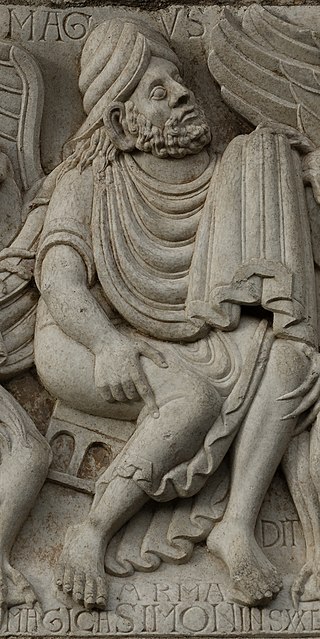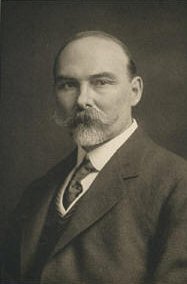
Simon Magus, also known as Simon the Sorcerer or Simon the Magician, was a religious figure whose confrontation with Peter is recorded in the Acts of the Apostles. The act of simony, or paying for position, is named after Simon, who tried to buy his way into the power of the Apostles.

The Gospel of Thomas is an extra-canonical sayings gospel. It was discovered near Nag Hammadi, Egypt, in December 1945 among a group of books known as the Nag Hammadi library. Scholars speculate that the works were buried in response to a letter from Bishop Athanasius declaring a strict canon of Christian scripture. Scholars have proposed dates of composition as early as 60 AD and as late as 250 AD. Since its discovery, many scholars have seen it as evidence in support of the existence of a "Q source" which might have been very similar in its form as a collection of sayings of Jesus without any accounts of his deeds or his life and death, referred to as a sayings gospel.
According to the Panarion of Epiphanius of Salamis, and Theodoret's Haereticarum Fabularum Compendium, the Borborites or Borborians were a Christian Gnostic sect, said to be descended from the Nicolaitans. It is difficult to know for sure the practices of the group, as both Epiphanius and Theodoret were opponents of the group. According to Epiphanius, the sect were libertines who embraced the pleasures of the earthly world.

Epiphanius of Salamis was the bishop of Salamis, Cyprus, at the end of the 4th century. He is considered a saint and a Church Father by both the Eastern Orthodox and Catholic Churches. He gained a reputation as a strong defender of orthodoxy. He is best known for composing the Panarion, a compendium of eighty heresies, which included also pagan religions and philosophical systems. According to Ernst Kitzinger, he "seems to have been the first cleric to have taken up the matter of Christian religious images as a major issue", and there has been much controversy over how many of the quotations attributed to him by the Byzantine Iconoclasts were actually by him. Regardless of this he was clearly strongly against some contemporary uses of images in the church.

The Nazarenes were an early Jewish Christian sect in first-century Judaism. The first use of the term is found in the Acts of the Apostles of the New Testament, where Paul the Apostle is accused of being a ringleader of the sect of the Nazarenes before the Roman procurator Antonius Felix at Caesarea Maritima by Tertullus. At that time, the term simply designated followers of Jesus of Nazareth, as the Hebrew term נוֹצְרִי, and the Arabic term نَصْرَانِي, still do. נוֹצְרִים (Nazarenes) can also be found in 2 Kings 17:9 and 18:8, in the Hebrew, but usually gets translated as, "watchtower" or "watchmen." The "tower of the Nazarenes" is described as the northern boundary in, 2 Kings 18:8.
Valentinus, also spelled Valentinius; c. AD 100 – c. 180, was the best known and, for a time, most successful early Christian Gnostic theologian. He founded his school in Rome. According to Tertullian, Valentinus was a candidate for bishop but started his own group when another was chosen.

The Gospel of the Hebrews, or Gospel according to the Hebrews, is a lost Jewish–Christian gospel. The text of the gospel is lost, with only fragments of it surviving as brief quotations by the early Church Fathers and in apocryphal writings. The fragments contain traditions of Jesus' pre-existence, incarnation, baptism, and probably of his temptation, along with some of his sayings. Distinctive features include a Christology characterized by the belief that the Holy Spirit is Jesus' Divine Mother and a first resurrection appearance to James, the brother of Jesus, showing a high regard for James as the leader of the Jewish Christian church in Jerusalem. It was probably composed in Greek in the first decades of the 2nd century, and is believed to have been used by Greek-speaking Jewish Christians in Egypt during that century.

The New Testament apocrypha are a number of writings by early Christians that give accounts of Jesus and his teachings, the nature of God, or the teachings of his apostles and of their lives. Some of these writings were cited as scripture by early Christians, but since the fifth century a widespread consensus has emerged limiting the New Testament to the 27 books of the modern canon. Roman Catholic, Eastern Orthodox, and Protestant churches generally do not view the New Testament apocrypha as part of the Bible.

The Gospel of the Ebionites is the conventional name given by scholars to an apocryphal gospel extant only as seven brief quotations in a heresiology known as the Panarion, by Epiphanius of Salamis; he misidentified it as the "Hebrew" gospel, believing it to be a truncated and modified version of the Gospel of Matthew. The quotations were embedded in a polemic to point out inconsistencies in the beliefs and practices of a Jewish Christian sect known as the Ebionites relative to Nicene orthodoxy.
Barbēlō refers to the first emanation of God in several forms of Gnostic cosmogony. Barbēlō is often depicted as a supreme female principle, the single passive antecedent of creation in its manifoldness. This figure is also variously referred to as 'Mother-Father', 'The Triple Androgynous Name', or 'Eternal Aeon'. So prominent was her place amongst some Gnostics that some schools were designated as Barbeliotae, Barbēlō worshippers or Barbēlō gnostics.
The Gospel of the Nazarenes is the traditional but hypothetical name given by some scholars to distinguish some of the references to, or citations of, non-canonical Jewish-Christian Gospels extant in patristic writings from other citations believed to derive from different Gospels.
The Naassene Fragment is a fragmentary text that survives in no document except a quotation in the early third century encyclopedia of heresies by Hippolytus of Rome called Refutation of All Heresies (5.7.2-9). It may be considered part of the New Testament apocryphal tradition. The Naassenes were a Gnostic Ophite sect. The fragmentary quotation is given by Hippolytus as expressing the fundamental ideas of the Naassene Ophites, and possibly of all Gnostics.
The Sethians were one of the main currents of Gnosticism during the 2nd and 3rd century CE, along with Valentinianism and Basilideanism. According to John D. Turner, it originated in the 2nd century CE as a fusion of two distinct Hellenistic Judaic philosophies and was influenced by Christianity and Middle Platonism. However, the exact origin of Sethianism is not properly understood.
Valentinianism was one of the major Gnostic Christian movements. Founded by Valentinus in the 2nd century AD, its influence spread widely, not just within Rome but also from Northwest Africa to Egypt through to Asia Minor and Syria in the East. Later in the movement's history it broke into an Eastern and a Western school. Disciples of Valentinus continued to be active into the 4th century AD, after the Roman Emperor Theodosius I issued the Edict of Thessalonica, which declared Nicene Christianity as the State church of the Roman Empire.

Poimandres is the first tractate in the Corpus Hermeticum.
The Naassenes were a Christian Gnostic sect known only through the writings of Hippolytus of Rome.

George Robert Stow Mead was an English historian, writer, editor, translator, and an influential member of the Theosophical Society, as well as the founder of the Quest Society. His works dealt with various religious and philosophical texts and traditions, including Neoplatonism, Hermeticism and Gnosticism.
Gnosticism in modern times includes a variety of contemporary religious movements, stemming from Gnostic ideas and systems from ancient Roman society. Gnosticism is an ancient name for a variety of religious ideas and systems, originating in Jewish-Christian milieux in the first and second century CE.
The Descent of Mary is a minor work of the New Testament apocrypha which is only known through mention in the Panarion of Epiphanius of Salamis, who gives a short passage. Epiphanius attributes the tale to the Gnostics.

This is a comparative religion article which outlines the similarities and interactions between Hermeticism and other religions or philosophies.








